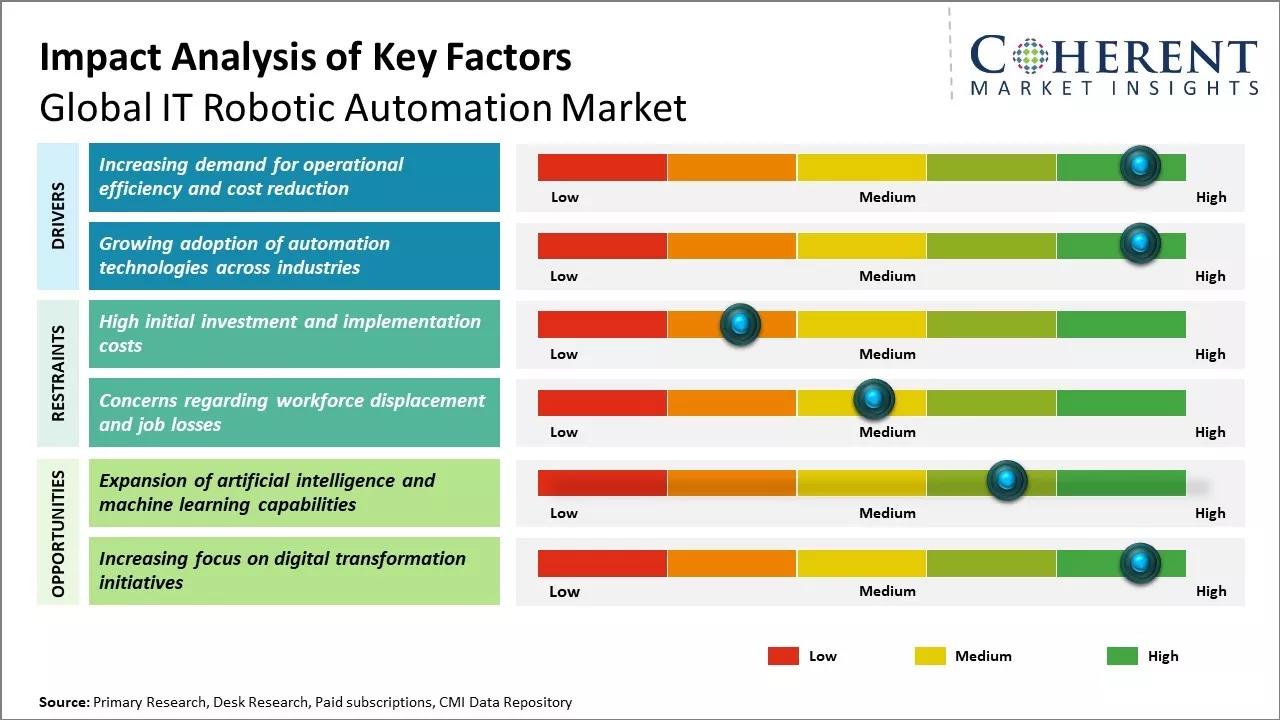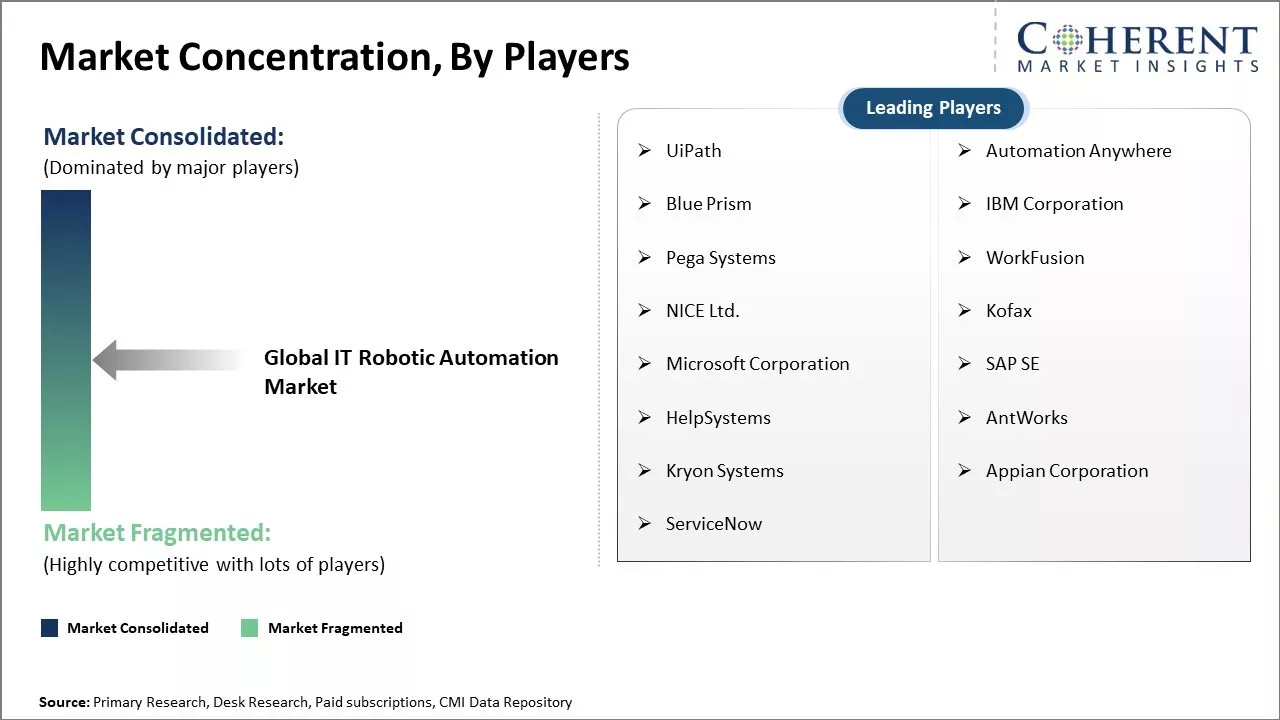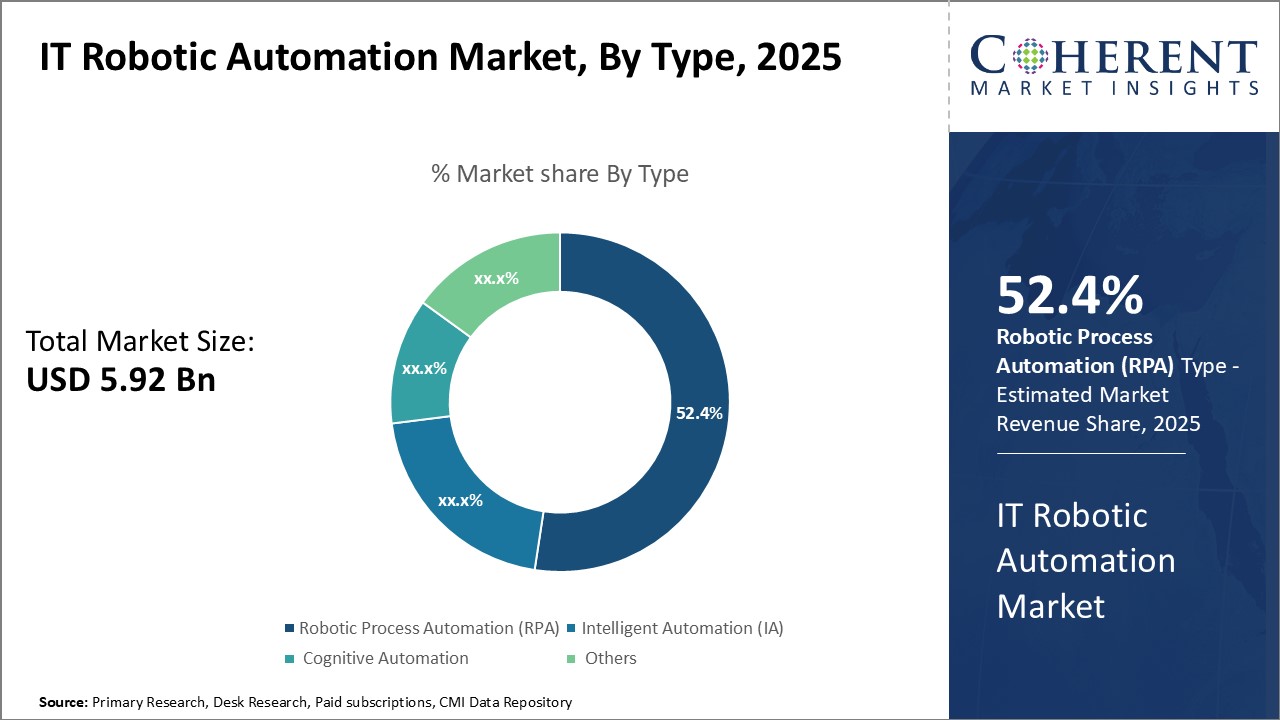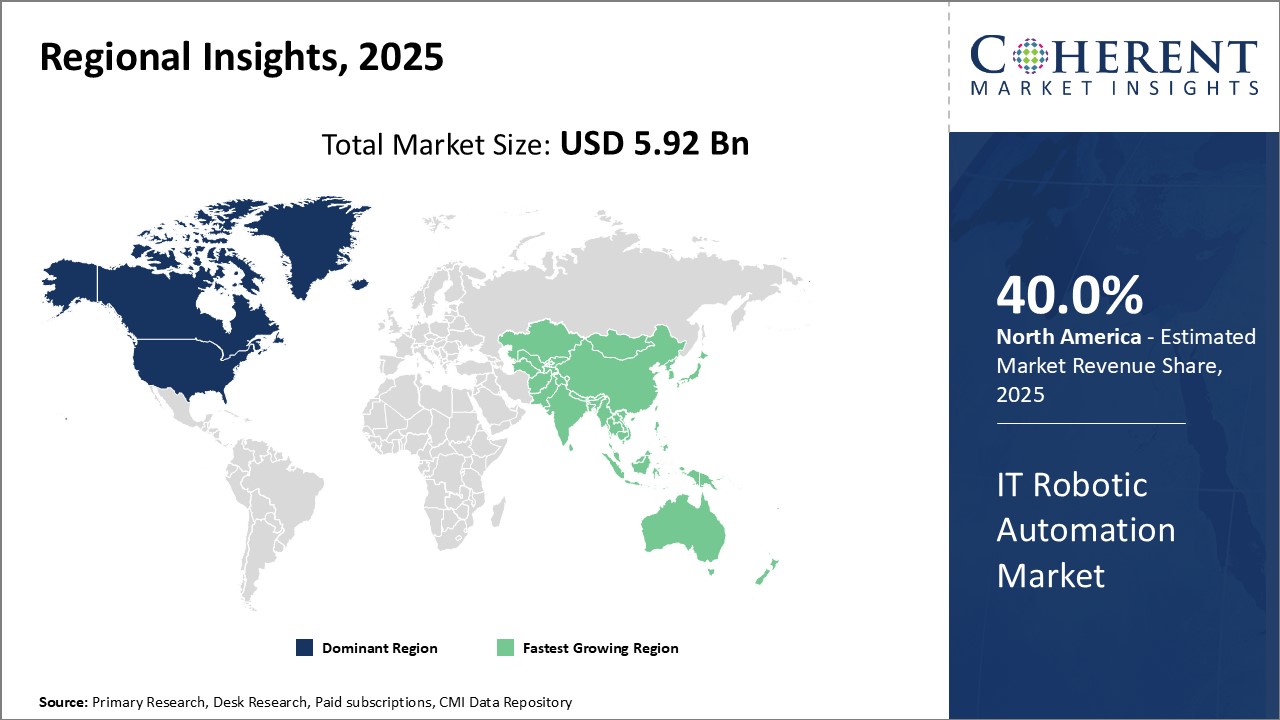
Global IT robotic automation market is estimated to be valued at US$ 5.92 Billion in 2025 and is expected to reach US$ 17.25 Billion by 2032, exhibiting a compound annual growth rate (CAGR) of 16.5% from 2025 to 2032.

Discover market dynamics shaping the industry: Download Free Sample
The rapid adoption of automation technologies across industry verticals is expected to drive significant growth in the Global IT Robotic Automation Market. Various organizations are increasingly implementing robotic process automation solutions to improve business process efficiency. The need to optimize operations and enhance productivity is a major factor boosting the demand for IT robotic automation.
The IT robotic automation market is expected to witness prominent growth driven by the rising demand for smart automated solutions, growing emphasis on regulatory compliance through automation, and increasing integration of artificial intelligence and machine learning capabilities in robotic process automation. Significant investments by IT companies in research and development of advanced robotic solutions are also expected to positively impact the market expansion from 2025 to 2032.
Market Driver - Increasing demand for operational efficiency and cost reduction
With the business environment becoming more competitive over the years, organizations across all industries are focusing on driving more outcomes while reducing operating costs. Manual and repetitive tasks that require human labor are increasingly being identified as areas where automation can bring improvement. IT robotic automation solutions are enabling companies to streamline business processes and optimize resource utilization through round-the-clock operation of software robots. These robots can perform high-volume repetitive jobs more accurately and at a much faster scale compared to human workers. This helps free up the workforce to focus on more strategic activities that deliver higher business value.
Many organizations have complicated IT infrastructure and applications to manage that involve numerous processes like security patch management, software testing, infrastructure monitoring, and incident response. With an expanding IT estate, the manpower requirements to handle such processes effectively grow tremendously. This is where adopting IT robotic automation comes into the picture. Intelligent software robots can be configured to execute standardized IT operations 24/7, thereby improving process efficiency. They bring transparency to otherwise complex IT processes through centralized monitoring and reporting. Automation ensures tasks are completed on time every time as robots don’t get impacted by human limitations. This helps IT teams at enterprises keep up with increasing workloads without continuously hiring more staff.

Get actionable strategies to beat competition: Download Free Sample
Growing Adoption of Automation Technologies across Industries
With new technologies emerging at a rapid pace, industries are undergoing extensive digital transformation. From manufacturing to healthcare to banking, automation is disrupting traditional business models. Progressive companies understand that embracing these disruptions is crucial to stay ahead of competition. Automation brings higher levels of accuracy, speed and standardization to business processes. It allows redesigning operations for superior agility to changing market dynamics. Technological convergence is enabling integration of emerging technologies like artificial intelligence, machine learning into existing IT systems. This is fueling the growth of intelligent automation across all functions within an organization.
The broader adoption of cloud, IoT and mobility has also created more opportunities for implementing automation. Cloud-based platforms now make it simpler for organizations to develop, deploy and manage automation solutions. Industries that have traditionally relied on manual labor are automating manufacturing process through robotics. Similarly, IoT and connected devices are triggering new use cases for automation in sectors like logistics, energy, and transportation. Knowledge workers are augmenting their skills with AI assistants. Such embrace of disruptive technologies is driving the need to automate associated IT processes through robotic solutions. Automation also addresses rising issues like skills shortage and support for remote working models in the post-pandemic era. As digital strategies take center stage, automated management of technology infrastructure and applications will continue gaining prominence across all industries.
For instance, In June 2023, Pega Systems, a leading provider of low-code software for customer engagement and process automation, introduced a new automation solution specifically designed for the healthcare sector. This innovative offering aims to enhance operational efficiency and improve patient outcomes by streamlining workflows and automating critical processes within healthcare organizations.
Key Takeaways from Analyst:
Global IT robotic automation market is experiencing significant growth driven by the increasing demand for automation across various IT operations. Various processes such as customer support, security operations and infrastructure monitoring are being automated to improve efficiency and reduce costs. North America currently dominates the market due to extensive R&D and presence of leading players. However, Asia Pacific is expected to be the fastest growing region with China and India offering huge opportunities.
While the market is growing rapidly, the lack of awareness and understanding of robotic automation capabilities among SMEs poses a challenge. Integrating legacy systems with new automated technologies is also inhibiting broader adoption. Data security continues to be a major concern for organizations. Skill shortage and talent gap in operating new age automated technologies can restrain the market to some extent.
However, the growing popularity of cloud-based platforms is eliminating infrastructure barriers. Increasing focus on smart workplace through productivity tools will boost the demand. There is a rising focus on implementing AI capabilities with automation to make the systems more intelligent and human-like. 5G technology rollout will further fuel the opportunities by enabling faster and more advanced automation solutions. Growing automation needs of industries like BFSI, manufacturing and healthcare will drive significant investments in the coming years. If integration challenges are properly addressed, the APAC region is likely to lead future growth.
Market Challenge - High initial investment and implementation costs
One of the key challenges faced by the global IT robotic automation market is the high initial investment and implementation costs associated with automation technologies. Adopting robotic process automation (RPA) requires a significant upfront capital expenditure to procure software licenses, configure workflows, integrate with existing IT systems, and train personnel. There are also ongoing operational costs such as software maintenance fees, upgrades to new versions, and technical support. For many small and medium enterprises, fitting the substantial costs of automation within their budgets can be a major hurdle that discourages adoption. Even large corporations need to make a strong business case to justify the high CAPEX and OPEX outlay for automation projects. Return on investment timelines may stretch to several quarters or years further complicating the financial viability. Thus, the hefty price tag attached to IT automation poses a real barrier to widespread deployment across the Global IT Robotic Automation Market.
Market Opportunity - Expansion of artificial intelligence and machine learning capabilities
One of the key opportunities for growth in the global IT robotic automation market centers on the expansion of artificial intelligence and machine learning capabilities. Automation software vendors are increasingly incorporating advanced cognitive capabilities into their solutions. This allows RPA bots to not just mimic repetitive tasks but make independent judgments and decisions with human-like cognition. As machine learning datasets expand, bots are gaining enhanced perceptive, language, reasoning and problem-solving abilities. They are leveraging AI to interpret complex documents, engage in natural conversations, spot anomalies, predict outcomes and recommend actions. As bots evolve into virtual assistants powered by AI, they will disrupt a wider range of processes across industries. This will significantly expand the scope of applications for robotic automation. The integration of AI is a major selling point attracting new adopters and enabling existing users to scale up deployments.

Discover high revenue pocket segments and roadmap to it: Download Free Sample
Insights By Type - Adoption of RPA in Information Technology Departments Boosts the Adoption of Robotic Process Automation (RPA)
In terms of type, the robotic process automation (RPA) segment estimated to contribute the highest market share of 52.4% in 2025 owing to its ability to streamline repetitive tasks performed by IT staff. RPA tools allow IT departments to configure software or "bots" to capture and interpret applications for processing a transaction, manipulating data, triggering responses and communicating with other digital systems. This automation frees up IT professionals to focus on more strategic functions. RPA is gaining popularity in the IT sector as it increases employee productivity by handling mundane, repetitive tasks and eliminates human errors that can occur during manual data entry or processing. The ability of RPA to integrate with existing backend systems seamlessly also enhances its appeal. Further, RPA software requires less time and money for implementation compared to other types of automation, prompting many IT departments to adopt this technology to stay ahead of the curve.
Insights By Deployment Mode - Cloud-based Deployment Empowers IT Teams with Scalability and Flexibility
In terms of deployment mode, the cloud-based segment is estimated to contribute the highest market share of 62.9% in 2025 due to the advantages it offers to IT teams in terms of scalability and flexibility. With cloud-based RPA, additional software "bots" can be deployed on demand within minutes as and when tasks increase. This on-demand scalability helps IT organizations rightsizing their infrastructure based on present workload. Cloud-based RPA solutions also allow IT professionals to access automation tools using any internet-connected device. This provides the flexibility for teams to work seamlessly from office or remotely. Further, cloud providers ensure software, infrastructure and security updates are managed automatically in the background. This allows IT teams to focus on strategic priorities rather than routine maintenance tasks. For instance, In July 2021, Automation Anywhere, a global leader in robotic process automation (RPA) software, acquired a cloud-based automation firm to expand its service offerings. This strategic acquisition is part of Automation Anywhere's ongoing efforts to enhance its platform and provide customers with more comprehensive automation solutions.
Insights By Application - Automation of Finance Operations Drives Robotic Adoption in the BFSI Sector
In terms of application, the banking, financial services, and insurance (BFSI) segment is estimated to contribute the highest market share of 37.2% in 2025. Within the BFSI segment, automation of back-office finance operations such as data entry, data reconciliation between systems, and account onboarding is driving increased RPA adoption. RPA is helping banks and financial institutions reduce processing time and eliminate manual errors associated with high-volume finance activities. Automated processing of tasks like customer KYC verification, credit applications and money transfers using RPA has substantially improved client experience. Further, RPA is enabling enterprises in the BFSI vertical to streamline regulatory compliance workflows with greater control and visibility. The ability of RPA to integrate seamlessly with legacy systems commonly used in financial organizations further boosts its suitability and demand for this sector.

Need a Different Region or Segment? Download Free Sample
North America has established itself as the dominant region in the global IT robotic automation market. The region is expected to hold 40.0% of the market share in 2025. Major IT companies from the U.S. such as IBM, Microsoft and Amazon have invested heavily in developing new solutions and platforms that leverage artificial intelligence and robotic process automation. This has provided local companies across industries access to cutting-edge automation technologies. The region is also home to many large enterprises who are at the forefront of adopting robotic automation at scale to streamline business operations. This growing demand has attracted major global RPA vendors to focus on the North American market by establishing research centers and partnerships with local technology providers. The availability of technical skills and presence of supportive infrastructure has further consolidated North America's leadership position.
Asia Pacific has emerged as the fastest growing regional market for IT robotic automation. Several factors are contributing to this rapid growth. Countries like India, China, Japan and South Korea have sizable business process outsourcing industries that rely on automation to improve productivity and reduce costs. Local technology giants including Rakuten, Tencent and SoftBank are investing strategically in automation startups and launched their own RPA products tailored for domestic as well as international clients. The strong government support through initiatives focused on digitization, smart manufacturing and Industry 4.0 is encouraging wider adoption of robotic automation across industries in Asia. Meanwhile, enterprises based in other developing Asian economies are displaying high enthusiasm in leveraging automation as part of their digital transformation journeys to enhance competitive edge. While pricing may be higher than alternatives, Asia Pacific is a crucial market given the growing prominence of its outsourcing industries and manufacturing sectors. This makes the region an attractive market for global as well as regional RPA suppliers.
IT Robotic Automation Market Report Coverage
| Report Coverage | Details | ||
|---|---|---|---|
| Base Year: | 2024 | Market Size in 2025: | USD 5.92 Bn |
| Historical Data for: | 2020 To 2024 | Forecast Period: | 2025 To 2032 |
| Forecast Period 2025 to 2032 CAGR: | 16.5% | 2032 Value Projection: | USD 17.25 Bn |
| Geographies covered: |
|
||
| Segments covered: |
|
||
| Companies covered: |
UiPath, Automation Anywhere, Blue Prism, IBM Corporation, Pega Systems, WorkFusion, NICE Ltd., Kofax, Microsoft Corporation, SAP SE, HelpSystems, AntWorks, Kryon Systems, Appian Corporation, and ServiceNow |
||
| Growth Drivers: |
|
||
| Restraints & Challenges: |
|
||
Uncover macros and micros vetted on 75+ parameters: Get instant access to report
Share
Share
About Author
Ramprasad Bhute is a Senior Research Consultant with over 6 years of experience in market research and business consulting. He manages consulting and market research projects centered on go-to-market strategy, opportunity analysis, competitive landscape, and market size estimation and forecasting. He also advises clients on identifying and targeting absolute opportunities to penetrate untapped markets.
Missing comfort of reading report in your local language? Find your preferred language :
Transform your Strategy with Exclusive Trending Reports :
Frequently Asked Questions
Joining thousands of companies around the world committed to making the Excellent Business Solutions.
View All Our Clients